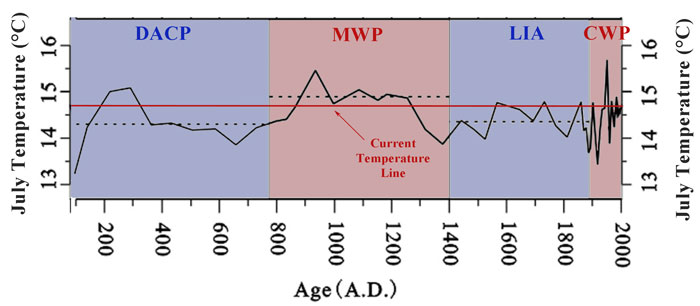| Tweet | Follow @co2science |
Paper Reviewed
Guo, C., Ma, Y., Meng, H., Hu, C., Li, D., Liu, J., Luo, C. and Wang, K. 2018. Changes in vegetation and environment in Yamzhog Yumco Lake on the southern Tibetan Plateau over past 2000 years. Palaeogeography, Palaeoclimatology, Palaeoecology 501: 30-44.
In providing the rationale for their study, Guo et al. (2018) say that current knowledge of climate change in the southern Tibetan Plateau (STP) is "far from satisfactory for depicting the temporal and spatial patterns in relation to the observed global changes over the past two millennia," adding that "no attention has been directed toward the high-resolution or well-dated pollen sequences for the last 2000 years." Thus, they reconstructed their own high-resolution record of climate and vegetation history for the STP over the past two millennia.
They accomplished their design by performing chronology, pollen, grain-size and chemical element analyses on four sediment cores obtained from Yamzhog Yumco Lake (28° 27' to 29° 12' N, 90° 08' to 91° 45' E, 4440 m above sea level) on the STP. Among other climate and vegetative reconstructions they produced is the annual mean July temperature reconstruction shown in the figure below. As depicted there, the STP has experienced four climate epochs over the past 2000 years. From approximately 0 to 780 AD the basin was cold and moist. Thereafter temperatures warmed and the climate was dry during the Medieval Warm Period (~780-1400 AD). Temperatures cooled once again during the ensuing Little Ice Age (~1400-1890 AD), which was also a wet period, after which the climate transitioned to warm and dry for the remainder of the reconstruction (i.e., the Current Warm Period).
Aside from the obvious millennial-scale climate oscillation seen in the temperature reconstruction below, it is important to point out that there is nothing unusual, unnatural or unprecedented about current temperatures on the STP. As indicated by the horizontal red line depicting the current temperature, there have been multiple times during the past two millennia when temperatures were warmer than present, including the 400 year period from 850-1250 AD, despite their being 50% less CO2 in the atmosphere than there is today. Because of this fact, it is clear that rising atmospheric CO2 is having little, if any, effect on current STP temperatures witnessed during the Current Warm Period.
But if not CO2, what is or could be the cause of the 20th century warming? Based on additional analyses performed by Guo et al., it was their conclusion that changes in solar irradiance "played the most important role in influencing the climatic variabilities over the STP on a multi-centennial timescale."
Sorry CO2, you are just not the important driver of temperature as climate alarmists make you out to be!

Figure 1. A 2,000 year reconstruction of mean July temperatures for the southern Tibetan Plateau revealing the Dark Ages Cold Period (DACP), Medieval Warm Period (MWP), Little Ice Age (LIA) and Current Warm Period (CWP) climate epochs. The horizontal red line illustrates the current temperature level at the end of the record. Source: Adapted from Guo et al. (2018).




